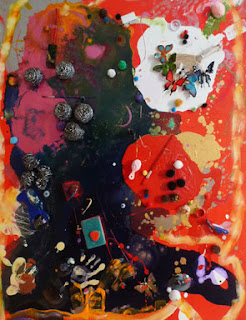 Named as a reference to the fact he is the last and only surviving child to seven sets of twins born to is mother, Prince Taiwo Olaniyi Oyewale-Toyeje Oyekale Osuntoki, or Prince Twins Seven-Seven, is an artist who I believe should be collected and held on to right now before the price elevation of African art influxes the market. I am under the belief that by 2016 or so, the African masters and Art from Africa and the Diaspora will begin to take on an increased significance in the contemporary art world. As a true master and founder of the Oshogbo school in the 1960s in Nigeria, Twins Seven Seven's abstract style of depicting Yorubaland themes through color and patterns on congested canvases was groundbreaking in that it transformed image to a symbolic representation through generalization. A self taught artist who embraced the new independence and nationalization of Nigeria, Twins Seven Seven was a true revolutionary, expressing traditional social beliefs that had been suppressed during European colonization through art, song, dance, and any other means of medium he could find. Prince reached the height of his artistic career in the mid 90s. He was so integral he received chieftancy in Ibadan and Ogidi towns, the birthplaces of his parents, and was then plagued by troubles ranging from political strife with the government to attempts by bandits and marauders on his life. His art began to suffer as a result of his personal struggles, and he moved to the United States permanently in 2000 to escape the demons that haunted him in Nigeria.
Named as a reference to the fact he is the last and only surviving child to seven sets of twins born to is mother, Prince Taiwo Olaniyi Oyewale-Toyeje Oyekale Osuntoki, or Prince Twins Seven-Seven, is an artist who I believe should be collected and held on to right now before the price elevation of African art influxes the market. I am under the belief that by 2016 or so, the African masters and Art from Africa and the Diaspora will begin to take on an increased significance in the contemporary art world. As a true master and founder of the Oshogbo school in the 1960s in Nigeria, Twins Seven Seven's abstract style of depicting Yorubaland themes through color and patterns on congested canvases was groundbreaking in that it transformed image to a symbolic representation through generalization. A self taught artist who embraced the new independence and nationalization of Nigeria, Twins Seven Seven was a true revolutionary, expressing traditional social beliefs that had been suppressed during European colonization through art, song, dance, and any other means of medium he could find. Prince reached the height of his artistic career in the mid 90s. He was so integral he received chieftancy in Ibadan and Ogidi towns, the birthplaces of his parents, and was then plagued by troubles ranging from political strife with the government to attempts by bandits and marauders on his life. His art began to suffer as a result of his personal struggles, and he moved to the United States permanently in 2000 to escape the demons that haunted him in Nigeria. "Untitled"- Prince Twins Seven Seven
Everyone loves a comeback. After 5 years of struggling to find his groove in America, Twins Seven Seven had a breakthrough in 2005, and was reaffirmed as an international sensation. He continued to work with various media, including drawings, textiles( he produced carpets with patterns and designs intricately woven into the material that depicted abstract themes), sculpture, and metal until his untimely death in June, 2011. You can procure a Twins Seven Seven painting (depending on size) for less than $5,000 US dollars, relatively inexpensive considering no more can be made.
That's all for now... until next time:










